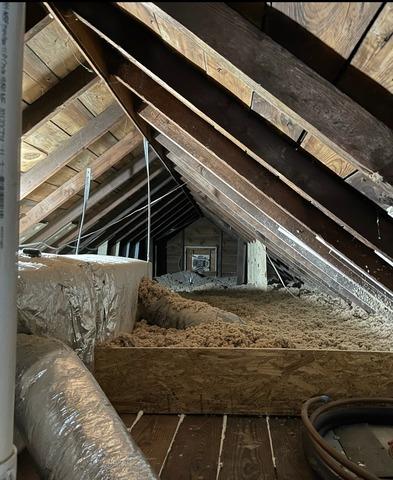Cellulose Insulation Services Near Smithtown, Saint James, Commack
Our Tru-Soft™ cellulose insulation is a smart alternative to fiberglass
Watch the video to see how cellulose insulation outperforms fiberglass insulation.
Cellulose insulation is sprayed or blown into walls, conforming to cavities to create a tight thermal barrier that provides superior comfort and helps save on energy costs. In comparison, fiberglass batts often leave gaps and voids that result in poor insulating performance.
Benefits of our cellulose insulation
- Reduces heating & cooling bills by as much as 32 percent (based on a study by The Leominster Housing Authority)
- Quiets a home better than fiberglass by reducing air infiltration through wall cavities
- Meets and exceeds fire-resistance testing
- Cellulose can be installed over existing insulation in most applications
To request an inspection and free insulation estimate, call Triple H Insulation at 1-631-265-4870 or click below! We are your local contractor for high-quality cellulose insulation in Saint James, Smithtown, Commack and surrounding areas of New York.
What makes our cellulose insulation "greener" than others?
All types of building insulation can be considered to be "green" products because they save energy, reducing harmful carbon emissions that result from burning fossil fuels. But our unique Tru-Soft™ cellulose insulation belongs in the category of "super-green" insulation materials because it contains up to 85 percent recycled paper - materials that would otherwise be dumped in landfills.
The reclaimed paper is processed in grinding machinery that creates a fluffy, lightweight material with insulation value as high as R-4 per inch. Tru-Soft™ cellulose requires significantly less energy to manufacture than fiberglass insulation. Manufacturing fiberglass for a home consumes six times more energy than manufacturing cellulose to insulate the same home at the same R-value.
Attic insulation additives provide resistance to fire, insects and mold
Our cellulose insulation is manufactured using a unique, two-stage process that injects both dry and liquid fire retardants to saturate the cellulose fibers. The result is an exceptional insulation with a Class 1 fire safety rating that meets and often exceeds stringent fire safety standards, helping to keep you and your family safe.
Our cellulose insulation also limits the amount of oxygen which can support a fire. The borate solution used to treat the insulation for fire retardancy also makes it resistant to mold and insects. Cellulose does not contain dangerous substances commonly found in building materials, including formaldehyde, volatile organic compounds, and glass fibers.
Three types of Tru-Soft™ cellulose provide a broad range of applications

Attic solution. Our Tru-Soft™ cellulose insulation offers an affordable and effective way to upgrade attic insulation. Treated to resist combustion, insects and mold, it can usually be blown into place on top of existing attic insulation.
Tru-Soft™ cellulose referred to as loose-fill or blown cellulose can be applied using blowing equipment. This technique is often used to insulate attics. One worker feeds cellulose into a hopper and blower unit that supplies shredded cellulose through a long hose to another worker in the attic space.
Our cellulose insulation can also be blown into wall cavities and other enclosed spaces. This application technique calls for 2-in.-diameter access holes to be drilled into the cavities, so that a small application nozzle can be inserted to inject the insulation. Because cavity-fill applications typically demand greater air pressure and a denser application, this technique is sometimes referred to as dense-pack cellulose. Access holes are plugged when the job is complete.
A third application technique, called wet-spray cellulose, is designed to apply cellulose insulation into open cavities found in new construction. Water and (in some cases) a liquid adhesive or binder compound is added to the dry cellulose during the application process. The level of wetness must be controlled so that the material is sticky but not so saturated that it will settle or fall out of place.
Save energy with high-performance Tru-Soft™ cellulose insulation
If you have an uncomfortable home or rising utility costs, call the insulation experts at Triple H Insulation today. Our home insulation experts will provide you with the quality solutions you need to ensure that your home is as comfortable and energy efficient as possible. Call us today at 1-631-265-4870 to schedule your home insulation inspection and free estimate. We proudly serve Hauppauge, Stony Brook, Brookhaven, Islip, Huntington, Huntington Station, Bay Shore and surrounding areas.
our service area
We serve the following areas





















